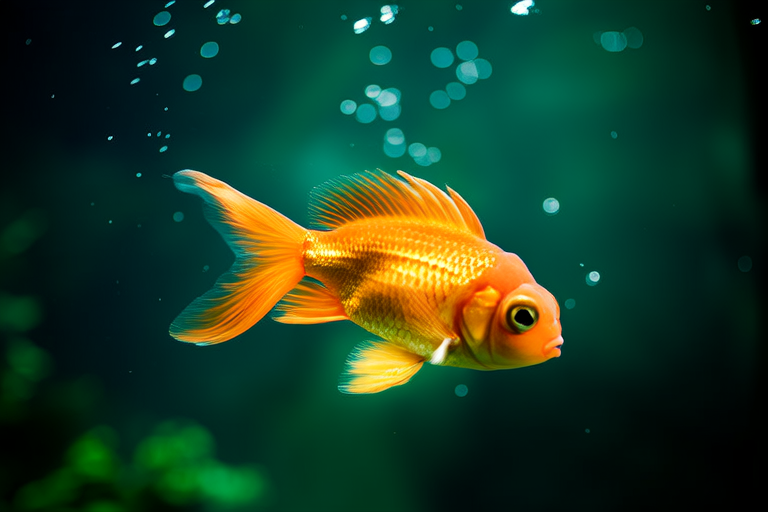Top Secrets for Keeping Your Goldfish Happy and Healthy
Welcome to the world of goldfish ownership! These delightful creatures bring joy and tranquility to many homes. However, to ensure your goldfish lead long, healthy, and happy lives, it’s crucial to understand their needs. This guide will provide you with top secrets to maintain your goldfish’s well-being, covering everything from tank setup to diet and health checks.
Ideal Tank Setup
The first step in keeping your goldfish happy and healthy is setting up an ideal tank environment. Goldfish require spacious tanks that can accommodate their growth. A general rule is to have at least 20 gallons of water for the first goldfish and an additional 10 gallons for each additional fish. Larger tanks reduce stress and provide more swimming space.
Goldfish produce a lot of waste, so a robust filtration system is necessary. The filter should be able to handle several times the volume of the tank per hour. This ensures that harmful toxins like ammonia and nitrite are removed from the water. Additionally, consider incorporating live plants into the tank. They not only enhance aesthetics but also improve water quality by absorbing nitrates and providing hiding spots.
Substrate choice is another important factor. Gravel or sand works well as substrate, providing a natural look and allowing beneficial bacteria to grow. Avoid sharp-edged decorations that could injure your fish. Instead, opt for smooth stones or driftwood. Lastly, ensure proper lighting; 8-12 hours of light per day is ideal. Natural sunlight can be harmful, so artificial lighting is recommended.
Water Quality Maintenance
Water quality is paramount for goldfish health. Regular water changes are essential to keep the tank clean and free from pollutants. Change about 25% of the water weekly, ensuring the new water matches the temperature and pH of the existing water to prevent shock.
To maintain optimal water conditions, monitor parameters such as pH, ammonia, nitrite, and nitrate levels regularly. Ideal pH for goldfish ranges between 6.5 and 7.5. Ammonia and nitrite should be undetectable, while nitrate levels should remain below 40 ppm. Use test kits to check these parameters and take corrective action if needed.
Aquarium salt can help prevent diseases and reduce stress. Adding 1 tablespoon of aquarium salt per gallon of water can be beneficial. However, avoid overuse, as excessive salt levels can harm sensitive species.
Appropriate Diet
Feeding your goldfish a balanced diet is key to their health. Commercial goldfish food provides essential nutrients but should not be the sole diet. Supplement with fresh vegetables like peas, spinach, and lettuce. These foods aid digestion and provide fiber. Frozen bloodworms and brine shrimp can serve as occasional treats.
Feed your goldfish small portions twice daily. Overfeeding leads to poor water quality and obesity. Observe your fish during feeding times to ensure all individuals are eating. Uneaten food should be removed promptly to prevent fouling the water.
Remember, goldfish are omnivores. Their diet should consist of both plant and animal matter. High-quality pellets or flakes formulated specifically for goldfish offer a good balance of nutrients. Always check the label to ensure the food meets your fish’s nutritional requirements.
Regular Health Checks
Performing routine health checks is vital for early detection of issues. Observe your goldfish daily for signs of distress, such as lethargy, loss of appetite, or unusual behavior. Cloudy eyes, bloated bodies, or frayed fins might indicate underlying problems.
External parasites, bacterial infections, and fungal infections are common among goldfish. If you notice any abnormalities, isolate the affected fish in a quarantine tank. Treatments like anti-parasitic medications or antibiotics may be necessary under veterinary guidance.
Veterinary care for goldfish is often overlooked but is crucial for their well-being. Consult a veterinarian specializing in aquatic animals for diagnosis and treatment of severe cases. Regular check-ups can prevent minor issues from escalating into serious health problems.
Suitable Tank Mates
Choosing compatible tank mates for your goldfish is essential. Goldfish are generally peaceful but can become aggressive when overcrowded or stressed. Opt for similarly-sized, non-aggressive species that thrive in similar water conditions.
Some suitable tank mates include other goldfish varieties, danios, and certain types of catfish. Avoid overly aggressive or territorial species like cichlids. Also, refrain from housing goldfish with tropical fish, as the difference in temperature requirements can cause stress.
Ensure there’s enough space for all inhabitants to coexist peacefully. Overcrowding increases competition for resources and leads to stress, which weakens the immune system and makes fish more susceptible to disease.
Environmental Enrichment
Providing stimulating environments helps reduce stress and promotes mental well-being. Incorporate floating objects, caves, and tunnels for exploration. These additions encourage natural behaviors and prevent boredom.
Introduce gentle water currents to mimic natural river environments. Goldfish enjoy swimming against the current, which enhances their exercise routine. However, avoid strong currents that could stress or injure them.
Consider rotating toys and decorations periodically to keep the tank interesting. This change in scenery prevents monotony and stimulates curiosity. Interactive feeding devices can also engage your goldfish, making mealtime more enjoyable.
Common Mistakes to Avoid
Overlooking water quality is a frequent mistake. Neglecting regular water changes or failing to monitor parameters can lead to harmful conditions. Another common error is overfeeding, which results in poor water quality and obesity.
Misunderstanding tank size requirements is another pitfall. Insufficient space restricts movement and increases stress. Similarly, choosing incompatible tank mates can lead to aggression and stress.
Finally, neglecting health checks can allow minor issues to develop into serious problems. Regular observations and timely interventions are crucial for maintaining your goldfish’s health.
In conclusion, keeping your goldfish happy and healthy requires attention to detail and commitment. By following these top secrets, you’ll create an enriching environment that supports your goldfish’s physical and emotional well-being. Remember, a thriving goldfish is a joyful one!
